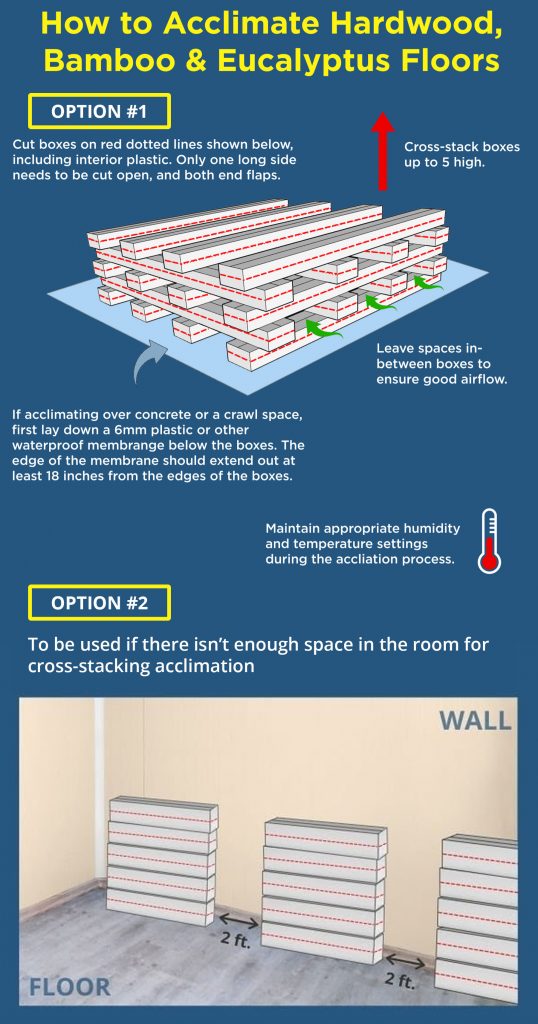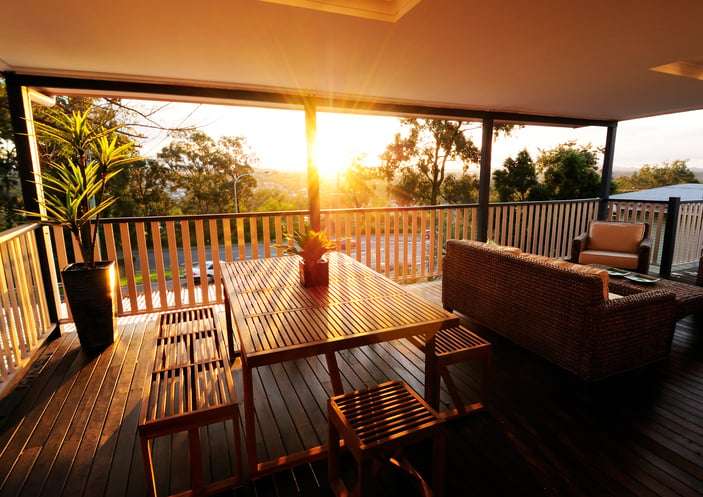Similar to other hardwood floors, bamboo flooring does require acclimation. Rigid core bamboo flooring typically acclimates in as little as 24 hours, while solid and engineered bamboo flooring requires a full 72 hours of acclimation before installation. However, for regions with extreme humidity fluctuations or unusually high or low levels of humidity, it is recommended to acclimate bamboo flooring for a week to ensure optimal performance.
Acclimation is the first and most important step to ensuring that your bamboo or hardwood floors provide a lifetime of quality use. How do I get started with the acclimation process, and what’s the point? This article will give a comprehensive glimpse into how to get your new flooring ready for the room!
What is Acclimation?
In the simplest sense, acclimation is where a material’s structures adjust to their surrounding environment – with the material changing temperature and humidity. As with flooring, acclimation means getting the wood accustomed to the environment in which it will be installed. This is done by turning on the climate control and placing and opening the boxes in the rooms they will be installed. There is a certain amount of time the flooring must stay like this before installation to allow the wood to balance itself out (acclimate) with the environment (read our guide on bamboo flooring installation).
Acclimation is important for flooring as bamboo and wood are porous, with microscopic holes that allow for air circulation. Along with this air comes the carrying of water molecules, i.e., humidity. All wood and bamboo flooring are hygroscopic, meaning it takes in and releases moisture to balance itself with the environment. Should the air in a room be more humid than the bamboo or wood, the planks will take on humidity, and if it’s too humid, they will swell slightly.
If the air in a room is less humid than the bamboo or wood, the planks will release humidity. If it’s too dry, they may shrink slightly, and if excessive, they may cup. When the atmosphere is less humid and the planks dry out, small gaps can develop between the flooring planks in winter and typically close up in summer when the humidity increases.
Do some brands need to be acclimated longer?
High-quality bamboo flooring requires at least 72 hours to acclimate, while lower quality brands require 1-2 weeks. All wood floors require some acclimation, and we recommend that you always follow the manufacturer’s installation instructions for detailed acclimation periods.
The differences between brands lie in the flooring’s moisture content – the higher the moisture content, the longer it will take to acclimate.
Testing the Moisture Content of Bamboo Flooring
Due to the planks’ sheer density and some binding resins, bamboo flooring can’t typically be tested for moisture in the same way hardwood flooring can. For classic bamboo floors, pin meters are recommended so you can insert the pins parallel to the grain to the same depth. For strand-woven bamboo, pinless (surface/face) meters are recommended.
Is Bamboo Flooring Sensitive to Moisture?
Excessive moisture and humidity can damage all wood flooring; however, bamboo is slightly more water-resistant than wood flooring (you can read more about this in our blog, Is Bamboo Flooring Waterproof?).
Specifically, bamboo flooring’s optimal environment is 40% to 60% humidity with a temperature range between 60 and 80 degrees Fahrenheit.
Steps To Acclimate Bamboo Flooring Properly
- Step 1: First, ensure the room’s humidity and temperature are at the right levels and won’t fluctuate too excessively. 40%-60% humidity is required for healthy wood and bamboo floors.
- Step 2: Cross stack the boxes for better airflow.
- Step 3: Cut open the long sides and end flaps of the flooring boxes, including the interior plastic, to ensure air can circulate through them.
- Step 4: Allow at least 72 hours for the bamboo flooring to acclimate to the room’s temperature and humidity. If you are in an excessively dry or humid climate, allow 10 days of acclimation instead of 3 days.
- Step 5: The bamboo flooring will be ready for installation as soon as the moisture content difference between the flooring and subfloor is within 3%.

There we have it, a quick guide to hopefully answer the question of whether your bamboo flooring needs to acclimate. At least now you know how humidity affects wood flooring and, in particular, bamboo flooring.
Does Bamboo Flooring Warp?

Here are a few common issues to avoid to keep your bamboo floors from warping:
Inadequate or No Acclimatization
Most high-quality bamboo floors require a minimum of 72 hour acclimation period. This means to stack the bamboo planks’ cases in the room they will be installed, open them properly to let them breathe, and allow the bamboo’s moisture level to stabilize the room’s humidity level before actually laying them down and affixing them. The boxes need to be cut open lengthwise, including interior plastic, to allow the floors to breathe. Many homeowners who install their bamboo floors in a weekend DIY project forgo this step, and the result is flooring that eventually warps.
Choosing A Low-Quality Brand
Always do your homework when purchasing such an important part of your renovation project. Also, be wary – don’t assume that just because the price is higher than you’re getting a high-quality floor. There are many known reasons for, and selecting a high-quality brand is on the list.
Poor Substrate Preparation
It is equally important to properly prep the substrate on which your new bamboo floors will be installed. This is especially critical when installing over a concrete subfloor where moisture can be a problem. If you have a crawl space, remember that it is considered part of the building envelope, and thus it must be sealed and ventilated. Otherwise, the moisture rising through the crawl space will buckle the flooring. Always follow the manufacturer’s standards and recommendations when preparing the substrate and sub-floors to avoid bamboo floors that warp.
Adhesive Application
Many homeowners who install themselves run into trouble when they adhere to the subfloors’ planks. They either use the wrong adhesive or use too much or too little. Sometimes, they may not allow the adhesive to cure properly before or during the installation causing moisture to seep into the bamboo planks. If you’re gluing down to concrete, you’ll want to make 100% sure to use a and make sure to use the correct trowel for that glue. Not following the adhesive’s directions carefully and accurately is another reason bamboo floors warp.
Not Enough Space for Expansion
Like when installing a hardwood floor, enough space (expansion gap of 1/4 to 1/2 inch) must be maintained around the perimeter walls and other vertical surfaces (like kitchen islands). If the manufacturer’s recommended expansion space is not followed, the bamboo planks will not have enough room to expand and buckle.
Spills
When liquids spill on your bamboo floors, wipe them up immediately. Failure to do so allows the bamboo to absorb the liquid and will eventually cause warping. It is also important to note that you should never use a steam cleaner on bamboo as these machines expose your bamboo planks to too much moisture leading to the dreaded warping.
Humidity
Lastly, it is essential to maintain your home’s humidity level per the manufacturer’s directions. A too humid or too dry room will wreak havoc on your floors, causing excessive expansion and contraction, which will eventually cause warping and buckling. Although you can’t control the humidity outside, you can easily do so inside with humidifiers in the drier winter months and dehumidifiers in the sticky summer months. Knowing you are purchasing can go a long way to avoiding these types of issues as well.
Bamboo floors are absolutely gorgeous and durable, but to ensure they look as lovely as the day you installed them and last for many years, you must install and maintain them properly.

About the Author
Jen is your go-to guru for crafting a cozy, green cocoon. 🪴 Her dive into sustainable building wasn’t just about saving the planet—it started as a mission to make family movie nights eco-friendly (and to ensure the popcorn was the only thing getting heated!). With a knack for breaking down the jargon, Jen turns eco-lingo into everyday language. Swing by the Green Living blog for a mix of earth-loving advice and home improvement hacks. Whether you’re just dipping your toes into green waters or you’ve been swimming in the deep end of DIY projects, Jen’s here to guide, giggle, and remind you that every eco-choice is a step towards a planet that thanks you… and maybe even sends a rainbow your way! 🌈

